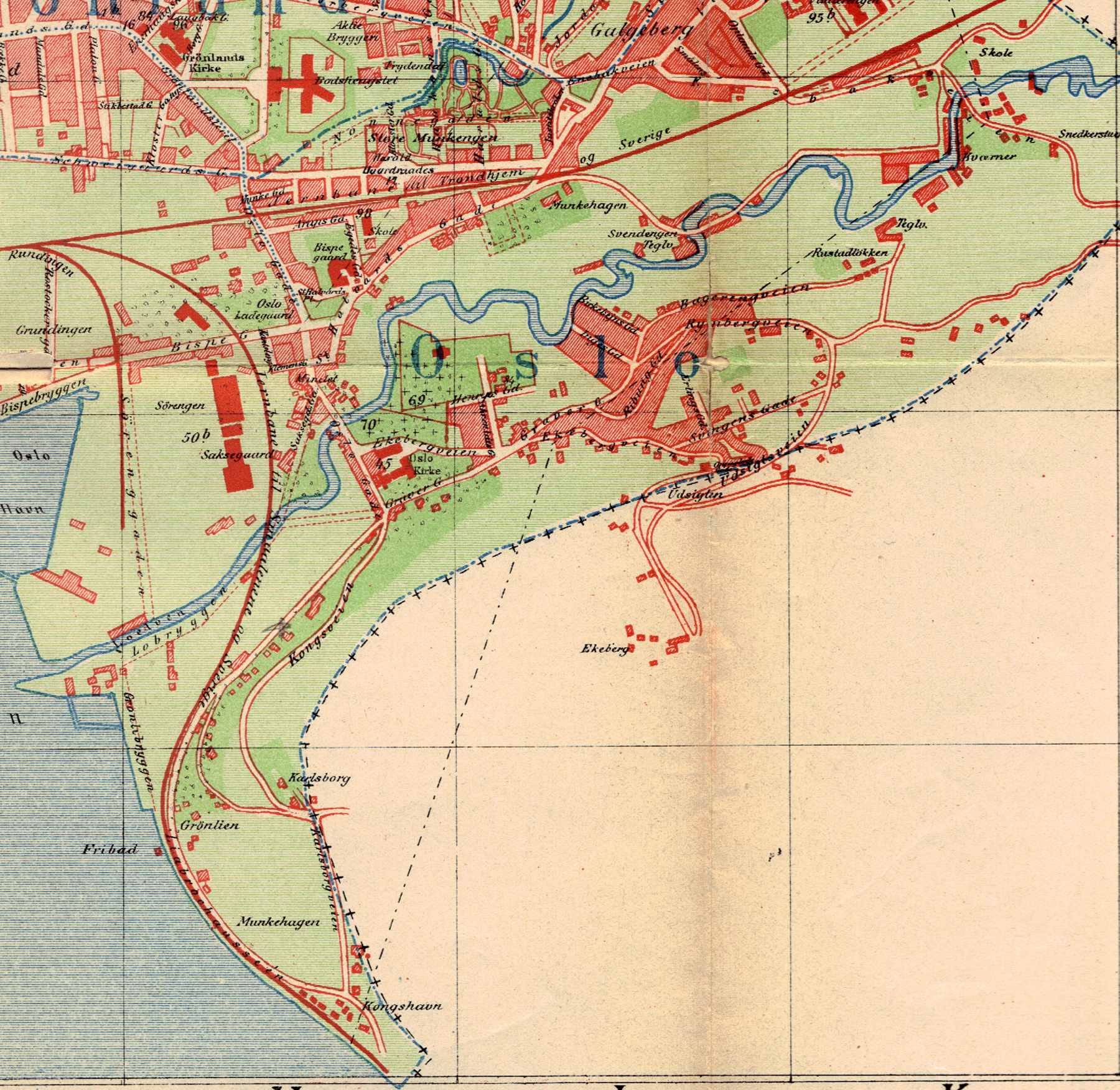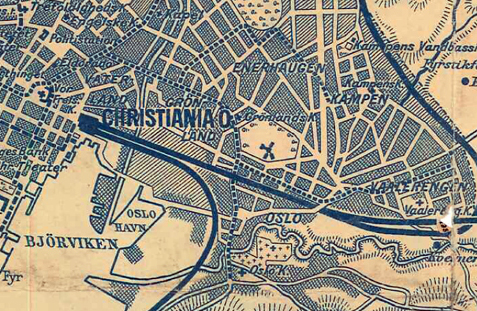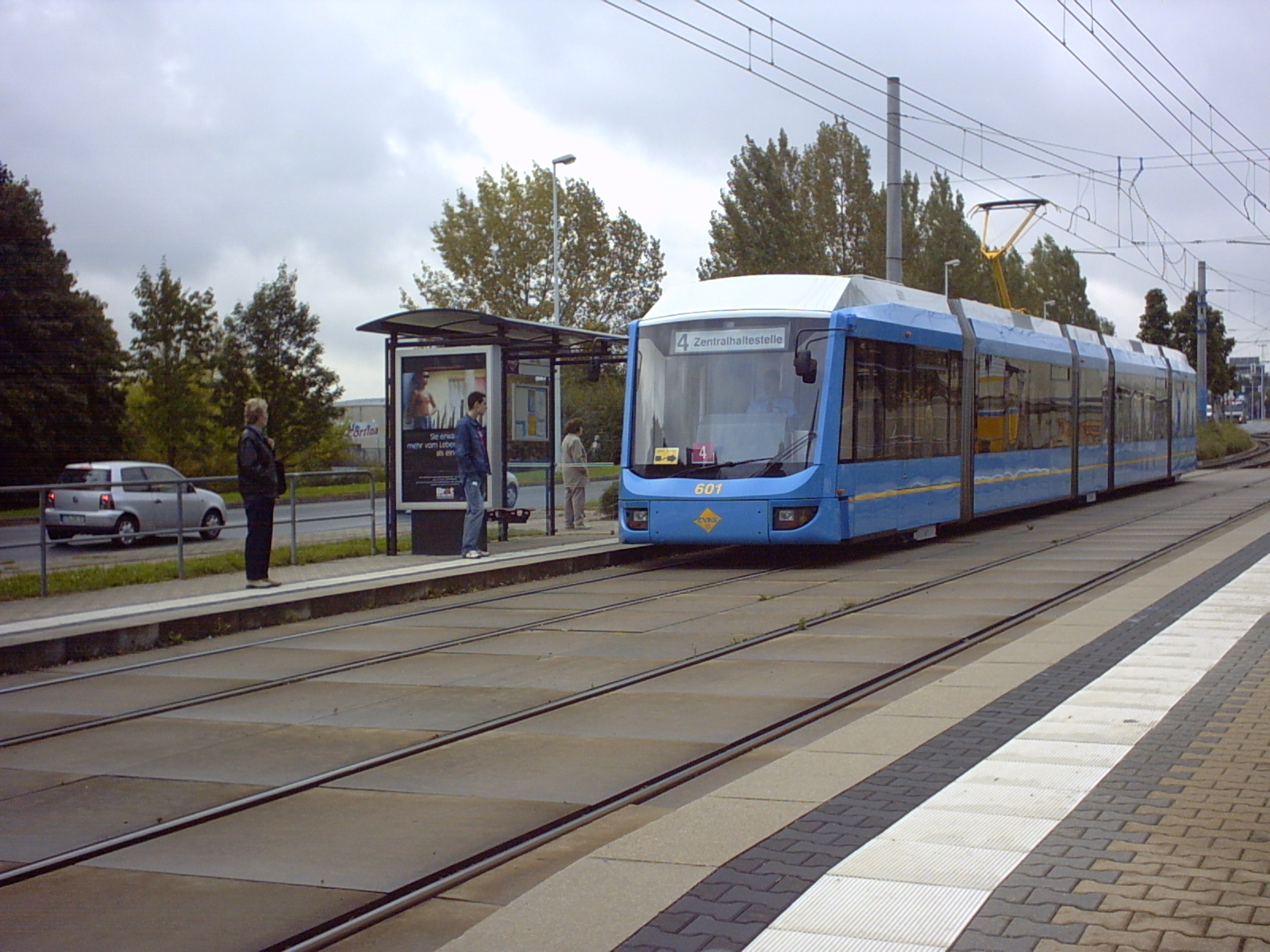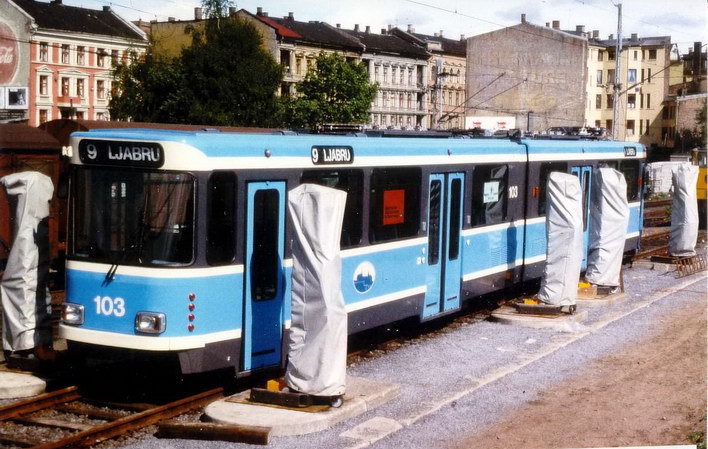|
Oslo Hospital (station)
Oslo Hospital is a light rail tram stop on the Ekeberg Line of the Oslo Tramway. It is located near Oslo Hospital in Ekeberg, in the borough of Gamlebyen, in Oslo, Norway. The station opened on 2 December 1878 as the terminus of the second segment of the Gamleby Line built by Kristiania Sporveisselskab. It was renamed following the change of name of the city from Kristiania to Oslo in 1925. On 11 June 1917 it also became the first station on the Ekeberg Line, after Ekebergbanen had built the suburban tramway to Sæter. The station is served by lines 13 and 19, using both SL79 and SL95 trams. Now, it is currently the terminus of the Bjørvika Line The Bjørvika Line is a tram line in Sentrum and Gamleby in Oslo. It opened as a rerouting of the Gamleby Line. The former route was closed down on the same day of this line's opening. It has two stops, Bjørvika and Middelalderparken. It runs .... References Oslo Tramway stations in Oslo Railway stations opened in 1875 1 ... [...More Info...] [...Related Items...] OR: [Wikipedia] [Google] [Baidu] |
Gamlebyen
The Old Town of Oslo ( no, Gamlebyen, ) is a neighbourhood in the inner city of Oslo, Norway, belonging to the borough of Gamle Oslo and is the oldest urban area within the current capital. This part of the capital of Norway was simply called Oslo until 1925 while the city as a whole was called ''Kristiania''. Oslo's old town was established with the urban structure around the year 1000 and was the capital of Norway's dominion in 1314. The main Old Town area (i.e. the southern and central parts of Old Town) has several ruins of stone and brick lying above ground, and large amounts of protected culture underground. The core area also has listed 1700s buildings. Towards Ekeberg slope and further up are some 17th and 18th-century wooden houses that are zoned for conservation under the Planning and Building Act, though there exist in the Old Town many four-storey brick houses, built at the end of the 1800s, and some heritage railway buildings from different eras. Mediaeval Oslo ... [...More Info...] [...Related Items...] OR: [Wikipedia] [Google] [Baidu] |
Gamleby Line
The Gamlebyen Line ( no, Gamlebylinjen) was a section of the Oslo Tramway which ran east from Jernbanetorget along Schweigaards gate (street), past the Bjørvika then turns south along Oslo gate, and past Gamlebyen before becoming the Ekeberg Line. The section was served by lines 18 and 19 before it was replaced by Bjørvika Line since October 2020. History The line was opened by Kristiania Sporveisselskab in 1875 as a horsecar route between Stortorvet and Gamlebyen. In 1900 the line was electrified, and received branch lines to Kampen and Vålerenga. The Vålerenga Line was extended to Etterstad in 1923, where there was a transfer to the Østensjø Line. Until 1925, the line was named the Oslo Line; with the name change of the city from Kristiania to Oslo, the district known as Oslo was renamed Gamlebyen. The plans from 1919 called for a common connection from the Østensjø Line and the Ekeberg Line to the city center, along with the proposed Lambertseter Line. The Ekberg Line w ... [...More Info...] [...Related Items...] OR: [Wikipedia] [Google] [Baidu] |
Oslo Tramway Stations In Oslo
Oslo ( , , or ; sma, Oslove) is the capital and most populous city of Norway. It constitutes both a county and a municipality. The municipality of Oslo had a population of in 2022, while the city's greater urban area had a population of in 2019, and the metropolitan area had an estimated population of in 2021. During the Viking Age the area was part of Viken. Oslo was founded as a city at the end of the Viking Age in 1040 under the name Ánslo, and established as a ''kaupstad'' or trading place in 1048 by Harald Hardrada. The city was elevated to a bishopric in 1070 and a capital under Haakon V of Norway around 1300. Personal unions with Denmark from 1397 to 1523 and again from 1536 to 1814 reduced its influence. After being destroyed by a fire in 1624, during the reign of King Christian IV, a new city was built closer to Akershus Fortress and named Christiania in honour of the king. It became a municipality (''formannskapsdistrikt'') on 1 January 1838. The city functi ... [...More Info...] [...Related Items...] OR: [Wikipedia] [Google] [Baidu] |
SL95
SL95 is a series of 32 low-floor, articulated trams operated on the Oslo Tramway. The series was built by Italian rail manufacturer Ansaldo/Firema, later known as AnsaldoBreda (now Hitachi Rail Italy), and delivered between 1999 and 2004. Capacity for the eight-axle, three-section vehicles is 212 passengers, of which 88 can be seated. The name derives from being ordered in 1995. Original plans called for the delivery to be between 1997 and 1998. Delivery took many years due to a magnitude of technical flaws, including high noise levels, freezing during the winter and corrosion. The trams are long, wide and tall. The aluminum vehicles weigh and have a power output of . The trams operate all services on lines 13, 17 and 18. Due to their heavy weight and large turning radius they are unsuitable for the other lines. However, they are the only bi-directional trams in the fleet, and are needed on lines 17 and 18 along the Ullevål Hageby Line. The trams cost about each, but discou ... [...More Info...] [...Related Items...] OR: [Wikipedia] [Google] [Baidu] |
SL79
SL79 is a class of 40 articulated trams operated by the Oslo Tramway of Norway. The trams were a variation of the Duewag trams that had been developed by the German manufacturer since the 1950s. The six-axle vehicles are unidirectional with four doors on the right side. The trams can seat 77 passengers three and four abreast, with an additional 91 people able to stand. Power output is , provided by two motors on the two end bogies, that supplement a central unpowered Jacobs bogie located under the articulation. The trams are long and wide. They are capable of and have standard gauge. They were built in two series, the first of 25 units delivered in 1982–84, and the second of 15 units delivered in 1989–90. The first 10 units were built by Duewag, while the last 30 were built in Norway by Strømmen. They were numbered 101 through 140. The two series vary slightly in specifications. The trams were ordered in 1979 after the 1977 decision to not close the tramway, after the SM53 ... [...More Info...] [...Related Items...] OR: [Wikipedia] [Google] [Baidu] |
Sæter (station)
Seter or Sæter may refer to: Farming *''Seter'' or ''Sæter'', a Scandinavian mountain pasture used in the practice of transhumance People * Arne Sæter (1913–1973), a Norwegian politician for the Christian Democratic Party * Einar Sæter (1917–2010), a Norwegian triple jumper, resistance member, newspaper editor and writer *Ingebrigt Haldorsen Sæter (1800–1875), a Norwegian politician and farmer *John Hou Sæter (born 1998), a Norwegian footballer who plays in midfield for Stabæk *Lars Sæter (1895–1988), a Norwegian politician for the Christian Democratic Party * Mordecai Seter (1916–1994), a Russian-born Israeli composer * Olaf Sæter (1872–1945), a Norwegian rifle shooter who competed in the early 20th century * Olav Jørgen Sæter (1884–1951), a Norwegian schoolteacher, newspaper editor and politician Places * Seter, Aukra, a village in the municipality of Aukra in Møre og Romsdal county, Norway *Seter, Indre Fosen, a village in ... [...More Info...] [...Related Items...] OR: [Wikipedia] [Google] [Baidu] |
Baneforlaget
Nils Carl Aspenberg (born 26 August 1958) is a Norwegian journalist, historian, author and businessperson. He has written numerous books on rail transport, and is chief executive officer of Baneforlaget. Aspenberg has a ''siviløkonom'' degree from BI Norwegian Business School. He worked as a conductor for Oslo Sporveier since 1980, and from 1981 tram and 1983-2003 subway engineer, as well as a bus driver since 1994. He has written more than thirty books on rail transport and local history and is owner of the publishing company Baneforlaget, which he founded in 1994. The company has published about 60 books. Aspenberg has been an active member of the Norwegian Railway Club, and was editor-in-chief of ''MJ-bladet'' from 1999 to 2003. He has also published the local history magazines ''Røakontakten'' from 1994 to 2008, and ''Langt Vest i Aker'' since 1997. He is also an editorial member of ''Lokaltrafikk'' and since 2013 also editor-in-chief. He is also an editorial member of '' B ... [...More Info...] [...Related Items...] OR: [Wikipedia] [Google] [Baidu] |
Kristiania Sporveisselskab
A/S Kristiania Sporveisselskab or KSS, nicknamed the Green Tramway ( no, Grønntrikken), was an operator of part of the Oslo Tramway from 1875 to 1924. The company was established in 1874 and started with horsecar operations on the Ullevål Hageby Line, Gamlebyen Line and the Grünerløkka–Torshov Line. The network was electrified with in 1899 and 1900, whereby the company was bought by Union-Elektricitäts-Gesellschaft. It delivered new Class U trams. Within a few years the company had also opened the Vålerenga Line and Kampen Line. It took over Kristiania Kommunale Sporveie in 1905, taking over its fleet of Class S trams and the Sagene Ring, the Vippetangen Line and the Rodeløkka Line. The company was based at Homansbyen Depot. From 1912 it started an extensive cooperation with its main competitor, Kristiania Elektriske Sporvei (KES). KSS also took delivery of the Class SS trams and from 1921 the Class H trams. The company build part of the Sinsen Line in 1923. Both ... [...More Info...] [...Related Items...] OR: [Wikipedia] [Google] [Baidu] |
Ekeberg
Ekeberg is a neighborhood in the city of Oslo, Norway. The Norway Cup soccer tournament takes place at Ekebergsletta every summer. "Sletta" means "the plain". The painting "The Scream" by Edvard Munch is painted from Utsikten ("the view"), a part of Ekeberg. In the area are a number of old Iron Age grave mounds and Bronze Age ritual sites. This establish the area of Ekeberg as one of the oldest inhabited places around Oslo. During the Middle Ages, the farm of Ekeberg belonged to Hovedøya Abbey. The area was later taken by the crown. From 1760, the farm of Ekeberg was run by an appointed owner, and his relatives owned the farm thereafter. In the area, a number of small homesteads under the main farm was erected the following century. The first suburban settlement came around 1900, and the early suburb was raised in the years prior to 1935. Many of the early houses are still present in the area. Ekeberg belonged to Oslo from 1947. In 1926 Roald Amundsen's airship ''Norge'', wa ... [...More Info...] [...Related Items...] OR: [Wikipedia] [Google] [Baidu] |
Oslo
Oslo ( , , or ; sma, Oslove) is the capital and most populous city of Norway. It constitutes both a county and a municipality. The municipality of Oslo had a population of in 2022, while the city's greater urban area had a population of in 2019, and the metropolitan area had an estimated population of in 2021. During the Viking Age the area was part of Viken. Oslo was founded as a city at the end of the Viking Age in 1040 under the name Ánslo, and established as a ''kaupstad'' or trading place in 1048 by Harald Hardrada. The city was elevated to a bishopric in 1070 and a capital under Haakon V of Norway around 1300. Personal unions with Denmark from 1397 to 1523 and again from 1536 to 1814 reduced its influence. After being destroyed by a fire in 1624, during the reign of King Christian IV, a new city was built closer to Akershus Fortress and named Christiania in honour of the king. It became a municipality ('' formannskapsdistrikt'') on 1 January 1838. The city fu ... [...More Info...] [...Related Items...] OR: [Wikipedia] [Google] [Baidu] |
Oslo Hospital
Oslo ( , , or ; sma, Oslove) is the capital and most populous city of Norway. It constitutes both a county and a municipality. The municipality of Oslo had a population of in 2022, while the city's greater urban area had a population of in 2019, and the metropolitan area had an estimated population of in 2021. During the Viking Age the area was part of Viken. Oslo was founded as a city at the end of the Viking Age in 1040 under the name Ánslo, and established as a ''kaupstad'' or trading place in 1048 by Harald Hardrada. The city was elevated to a bishopric in 1070 and a capital under Haakon V of Norway around 1300. Personal unions with Denmark from 1397 to 1523 and again from 1536 to 1814 reduced its influence. After being destroyed by a fire in 1624, during the reign of King Christian IV, a new city was built closer to Akershus Fortress and named Christiania in honour of the king. It became a municipality (''formannskapsdistrikt'') on 1 January 1838. The city f ... [...More Info...] [...Related Items...] OR: [Wikipedia] [Google] [Baidu] |
Oslo Tramway
The Oslo tram network ( no, Trikken i Oslo, short from ', 'electric') is the tram system in Oslo, Norway. It consists of six lines with 99 stops and has a daily ridership of 132,000. It is operated by , a subsidiary of the municipally-owned who maintain the track and 72 tram vehicles on contracts with the public transport authority . The system operates on standard gauge and uses 750 V DC overhead. Depot, workshops and headquarters are at (at the terminus of lines 13 and 17). There is also a depot at (along lines 18 and 19) that is home to the technical company InfraPartner, which maintains the track for the tram and metro systems in Oslo, and a small office building for . History The first tram in Oslo was opened in 1875 with a short line between Homansbyen west of the city centre, Oslo West Railway Station and a sideline to Grønland, east of the city centre. The first "trams" were in fact horse-drawn vehicles on flanged steel wheels. The first expansion of the line came ... [...More Info...] [...Related Items...] OR: [Wikipedia] [Google] [Baidu] |








